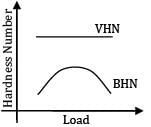Test: Mechanical Testing Of Materials - Mechanical Engineering MCQ
10 Questions MCQ Test - Test: Mechanical Testing Of Materials
In _________ test, there are two kinds of notches.
When a wire is subjected to an axial load then its length becomes 1.5 times of initial length, then what is the value of Young’s modulus?
| 1 Crore+ students have signed up on EduRev. Have you? Download the App |
Which of the following graph represents the correct relation between various hardness numbers and applied load?
During hardness test the indenter is usually a
A load of 2 N is applied on a specimen during hardness testing. Find the length of the diagonal of indenter in (mm) used in Knoop test.
Calculate the Vickers hardness number when a 3 kg load yields on indentation diagonal length of 0.10 mm.
What is the indentation diagonal length when a load of 2 kg produces a Vickers hardness number VHN is 400.
If a Rockwell test is performed and the depth of penetration is 60 mm and the load applied is 60 kg. Find the hardness number (HRA).
If a material has a target hardness of 300 HB and a load of 2.6 kN is applied on a specimen of diameter 10 mm. Find the radius of indentation.
A load of 2.2 kN is applied on a specimen during hardness testing diameter of steel ball is 10 mm and radius of indentation is 0.65 mm. What will be the value of hardness?


















